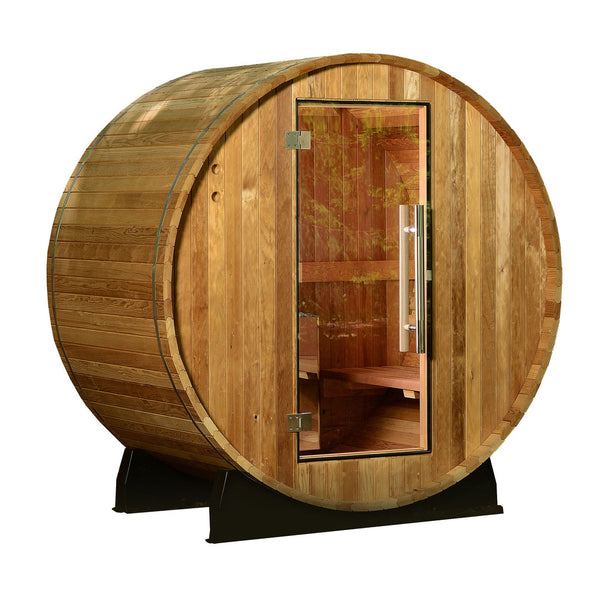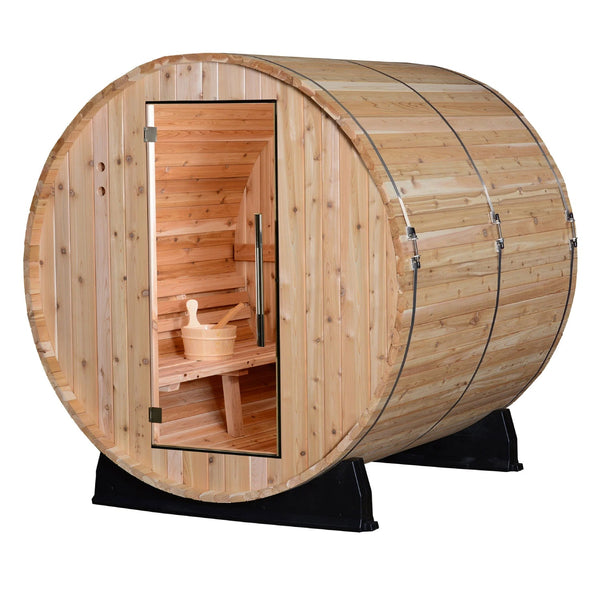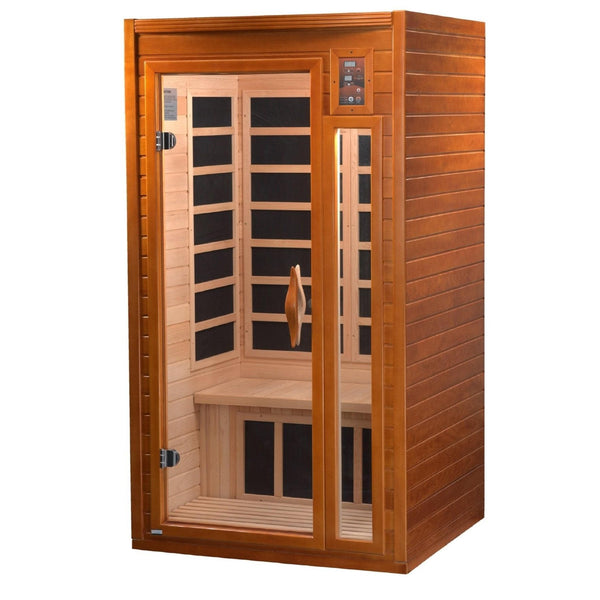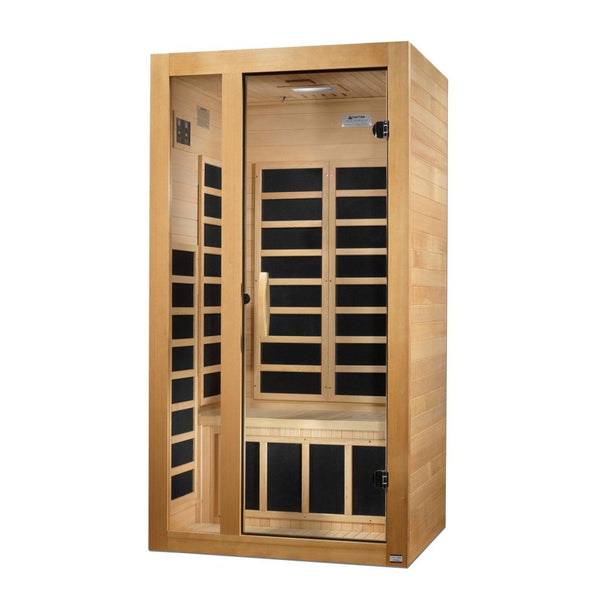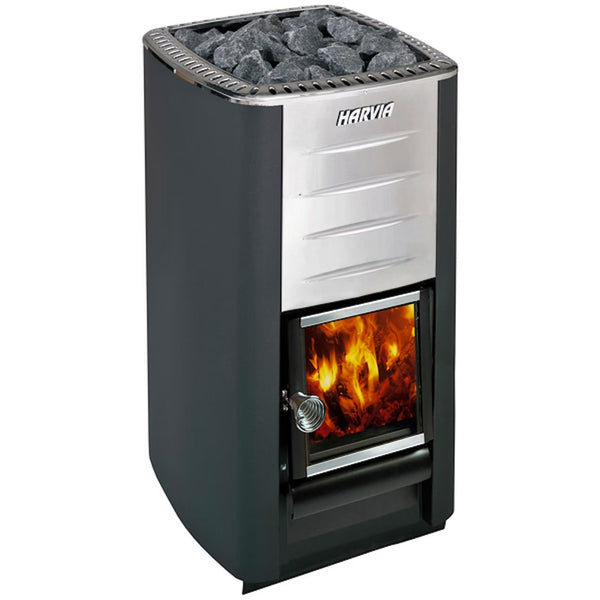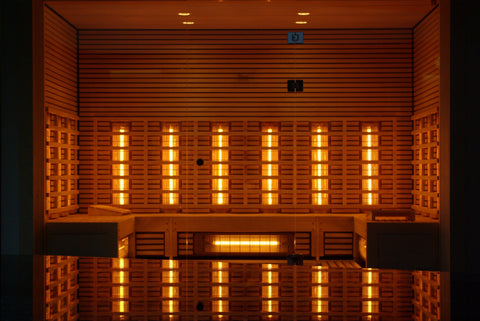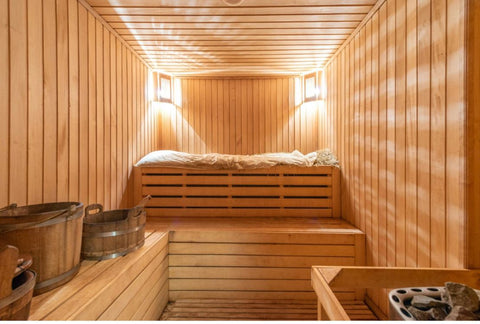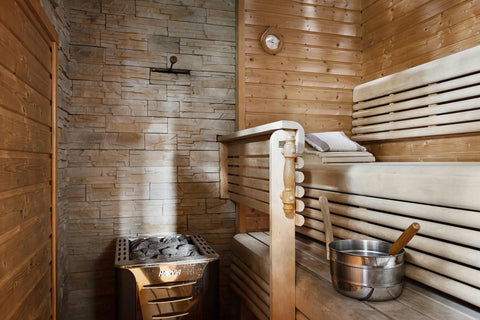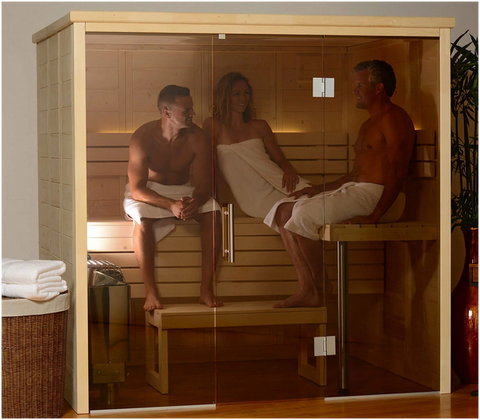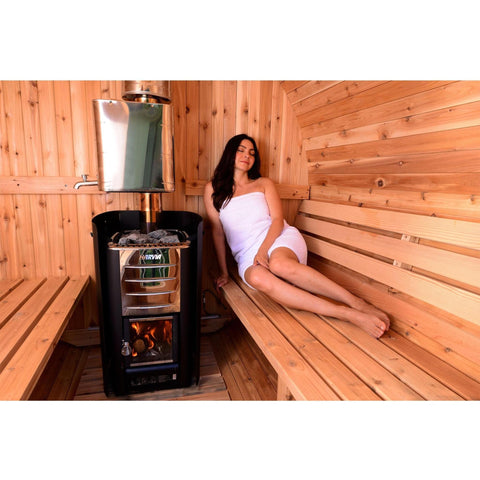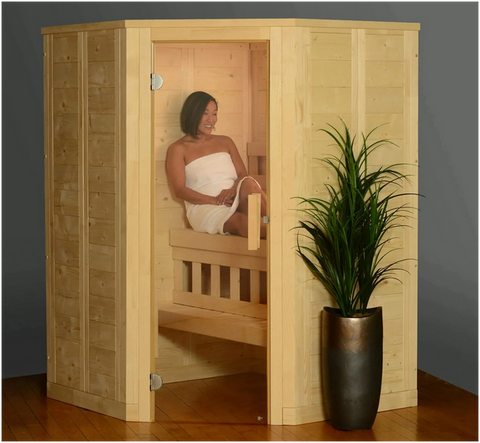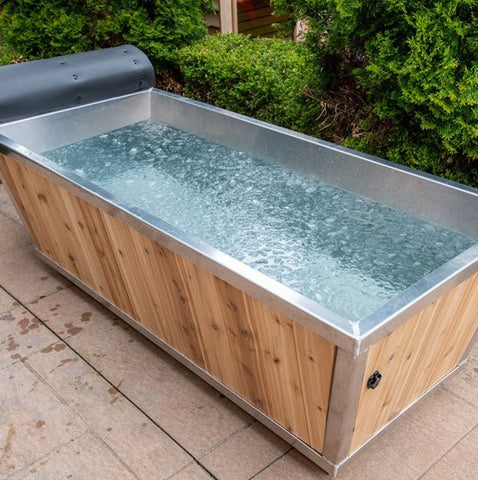
Welcome to our comprehensive guide on infrared and traditional saunas!
If you’ve ever wondered about the differences between these two types of saunas — how they work, their benefits, risks, and more, you’re in the right place. We’ve compiled everything you need to know in this article, answering the most frequently asked questions.
So, let’s dive in and explore the world of saunas together!
The Main Difference Between Infrared and Traditional Saunas
When it comes to heat therapy, there are two main sauna types: traditional saunas and infrared saunas.
While both offer a relaxing experience and a host of health benefits, each type of sauna operates differently in the type of heat it provides.
Infrared saunas use infrared light to heat your body directly, resulting in a more intense sweat at a lower temperature. This makes them a good option for those who can’t tolerate the heat of a traditional sauna session.
On the other hand, a traditional sauna heats the air around you. Its heat is typically more intense, with temperatures ranging from 150 to 195 degrees Fahrenheit.
|
DID YOU KNOW? The use of saunas is so deeply ingrained in Finnish culture that they see it as a ‘church of nature’ that enhances the spiritual experience. |
Here’s a more detailed comparison of the two:
|
Feature |
Infrared |
Traditional |
|
Heat Source |
Infrared light |
Heated rocks and water |
|
Heat Type |
Direct, penetrates more deeply into the body |
Indirect, heats the air around you |
|
Temperature |
Lower (120-150 degrees Fahrenheit) |
Higher (150-195 degrees Fahrenheit) |
|
Humidity |
Low |
Can be high if water is used |
|
Heating Time |
Faster, as it heats the body directly |
Slower, as it heats the air first |
When choosing between traditional and infrared saunas, consider your heat tolerance, the kind of heat you prefer, and the benefits you want to gain from your sauna experience.
Both types have their unique advantages, so it’s all about finding what works best for you. The team of Sauna experts at Select Saunas is here to help you choose the best one for you. We have saunas of every kind, so you’re in good hands!
How Infrared Saunas Work
Instead of heating the air around you, infrared saunas use infrared lamps to warm your body directly.
Infrared light produces a type of energy that’s on the invisible spectrum of light. This is the same type of heat that the sun produces, but without the harmful ultraviolet rays.
Here’s a simple step-by-step breakdown of how an infrared sauna session works:
- You turn on the sauna and the infrared heaters start to emit infrared light.
- The infrared light waves penetrate deep into your body, heating it directly.
- Your body absorbs the infrared heat, increasing your body temperature.
- As your body temperature rises, you start to sweat to cool down.
- The sweat helps to flush out toxins, leading to a range of potential health benefits.
They can operate at lower temperatures compared to their traditional counterparts. This can make them a more comfortable option for those who can’t tolerate extremely high heat.

How Traditional Saunas Work
In a traditional sauna, the heat is generated by a stove, which can be electric, wood-fired, or gas.
Here’s a step-by-step breakdown of how it works:
- Heat the stove. This can take anywhere from 30 minutes to an hour, depending on the type of stove and the size of the sauna.
- The stove heats up a pile of rocks. These rocks can retain a lot of heat and are a key component of the experience.
- Once the rocks are hot enough, you can throw water on them. This creates steam, which increases the humidity and helps distribute the heat evenly throughout the sauna.
- Sit back and enjoy the heat.
The heat is quite intense, but the humidity levels can vary depending on how much water you throw on the rocks.
The combination of high heat and humidity in these sauna sessions can make the experience quite intense, but it’s also incredibly relaxing and rejuvenating.
Note that you can also have a traditional dry sauna, which heats the room using stones or a heater without adding moisture to the air.
Energy Efficiency of Infrared and Traditional Sauna
Infrared saunas are generally more energy-efficient. The key factor contributing to this difference lies in the method of heat generation and distribution.
An infrared sauna directly heats the body, making it more energy-efficient as it does not require heating the air inside the sauna. Infrared saunas typically operate at lower temperatures, which further contributes to their energy efficiency.
On the other hand, traditional saunas heat the air inside the sauna, which then heats the body. This indirect method of heating requires more energy. They operate at higher temperatures, which requires more energy to maintain.
To put it in perspective, a typical infrared sauna uses about 1.6 kilowatts of power, while a traditional one uses around 6 kilowatts. This means that, on average, an infrared sauna uses about 60-75% less energy.
The energy efficiency of a sauna can also be influenced by other factors such as its size, the materials used in its construction, and how well it’s insulated.
Therefore, while infrared saunas are generally more energy-efficient, a well-designed and well-insulated traditional sauna can also be energy-efficient. In the end, infrared sauna benefits trump the traditional ones when it comes to energy efficiency and eco-friendliness.
Here’s a simple comparison to illustrate these differences:
|
Sauna Type |
Average Operating Temperature |
Average Power Usage |
|
Infrared |
120°F - 140°F |
1.6 kilowatts |
|
Traditional |
150°F - 195°F |
6 kilowatts |
If energy efficiency is a key consideration for you, get an infrared sauna. However, it’s always a good idea to consider all factors, including your personal comfort and the specific health benefits you’re seeking, before making a decision.
Effectiveness of Infrared and Traditional Sauna
Both forms of sauna therapy have their unique advantages. The choice between the two often comes down to personal preference and specific health goals.
Infrared sauna sessions produce more intense sweat at a lower temperature. This can be particularly beneficial for those who prefer sauna bathing at a lower temperature.
On the other hand, traditional saunas produce a high-temperature environment. This can lead to a more intense overall heat experience, which some sauna users prefer.
Both forms of sauna therapy have a long list of benefits in terms of health, which include:
- Stimulates blood flow and improves circulation
- Helps the body eliminate toxins more effectively
- Helps relieve muscle aches and joint pain
- Increases heart rate and metabolic rate to aid in weight loss
- Helps boost the immune system by promoting the production of white blood cells
- Helps promote relaxation and reduce stress
- Cleanses the skin and opens up the pores, leading to a healthier and clearer complexion
Ultimately, the choice between an infrared and traditional sauna often comes down to personal preference and tolerance to heat. Regardless of the type, sauna use gives you incredible health and wellness benefits.
|
DID YOU KNOW? Studies show that people who go to a hot sauna have lower chances of high blood pressure, heart attacks, and strokes. It doesn’t matter whether it’s regular dry sauna bathing or the use of radiant heat, the benefits are real and significant. |
Cost Difference Between Infrared and Traditional Sauna
When considering how much does a sauna cost, there several factors come into play. These include the initial purchase price, installation costs, and ongoing expenses such as energy usage and maintenance.
The initial purchase price of an infrared sauna would depend on the size, brand, and features. Installation costs can also vary widely based on the complexity of the installation and whether any structural modifications are needed.
Infrared saunas are easier and less expensive to install, as they often come in prefabricated kits and do not require a dedicated electrical circuit. As such, infrared sauna use is possible even in urban centers.
Traditional saunas, on the other hand, may require professional installation and electrical or gas piping work, which can add to the overall cost. Out range of outdoor saunas for sale start from prices as low as $4,000
In terms of ongoing costs, infrared saunas are generally more energy-efficient because the infrared light heats the body directly, which requires less energy than heating the air and surfaces in a traditional sauna. This can result in lower electricity bills over time.
Maintenance costs for both types of saunas are relatively low but can include expenses for cleaning supplies, replacement parts, and occasional servicing.
It’s important to note that these are general estimates and actual costs can vary based on individual circumstances and preferences.
Traditional or infrared sauna use will typically enhance your wellness routine, promoting relaxation and health benefits that far outweigh the minimal maintenance costs.

Maintaining Infrared and Traditional Saunas
Both infrared and traditional saunas require certain measures to ensure their longevity and optimal performance. However, the nature and frequency of these maintenance tasks can vary between the two types of saunas.
Infrared saunas are generally easier to maintain due to their design and technology. They do not use water or steam, which eliminates the need for regular cleaning to prevent mold and mildew. The infrared panels used for heating also have a longer lifespan and rarely need replacement.
The main maintenance tasks for infrared saunas include:
- Regularly wiping down the interior with a damp cloth to remove sweat and body oils.
- Occasionally cleaning the exterior with a suitable wood cleaner.
- Checking the electrical components periodically to ensure they are functioning properly.
For those who love frequent sauna use, infrared saunas are much better compared to a regular sauna room.
Traditional saunas, on the other hand, typically require more frequent and intensive maintenance. This is primarily due to their use of water and steam, which can lead to the growth of mold and mildew if not properly managed.
For electric and traditional dry saunas, the sauna heating unit may need to have the heating elements replaced more frequently.
Primary maintenance tasks for a traditional sauna include:
- Clean the interior to remove sweat and body oils and prevent mold and mildew.
- Frequently air out the sauna to remove moisture.
- Check and replace the rocks in the heater as needed.
- Inspect the sauna regularly for any signs of wood damage or decay.
While both types of saunas require regular maintenance, the infrared version is generally easier and less costly to maintain than traditional saunas.
The friendly team of sauna professionals here at Select Saunas is always ready to help you factor in considerations like this as you shop around for the ideal sauna.
Conclusion
Both infrared and traditional saunas offer unique benefits and experiences. The choice between the two often depends on individual preferences, health conditions, and practical considerations such as cost, installation, and maintenance.
While infrared saunas operate on the principle of infrared radiation penetrating the skin for heat generation, traditional saunas heat the air around the user. Plus, only a wet sauna can create a proper steam room for those who prefer a traditional sauna bath.
Sauna bathing in each type of sauna brings potential health benefits but also carries certain risks and side effects. Consult with a healthcare provider before beginning any new health regimen, including sauna use.
Once you decide whether you want a traditional sauna or an infrared sauna, browse through our collection of saunas for sale to find one in the right size and budget range to suit your needs. Relax, we’ve got you covered!



